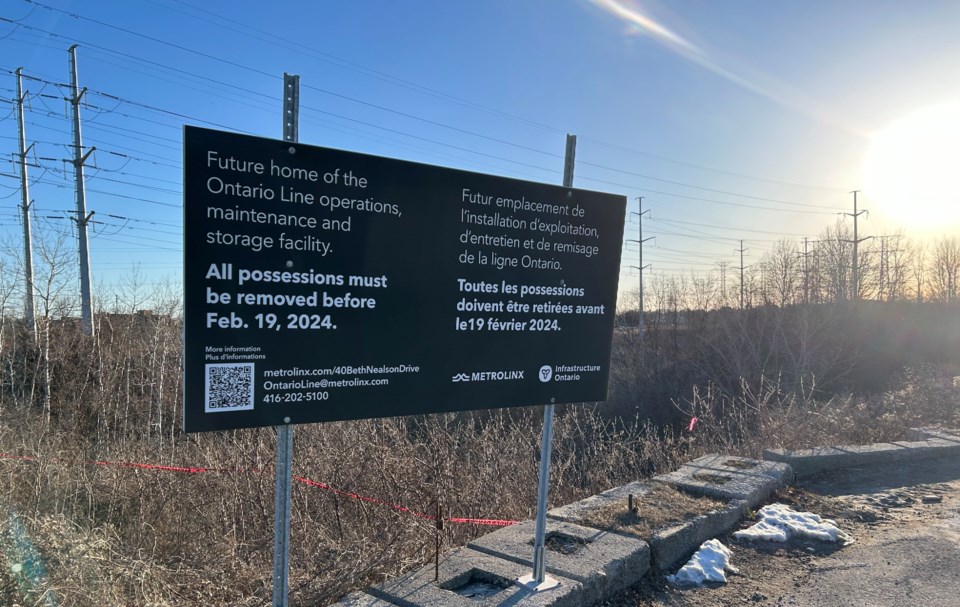Thorncliffe Park will look a lot different in a decade-and-a-half.
Sometime before 2040, thousands will move into newly built towers with a “vibrant, mixed-use” community just outside their front doors. A few more steps will take them to a network of trains connecting them to all the jobs and entertainment the rest of Toronto has to offer.
That’s if things go according to plan.
After years of planning, Metrolinx has begun reshaping Thorncliffe Park. The community in the heart of Toronto is one of the city’s lowest-income neighbourhoods. It's home to almost 30,000 residents, most of whom are visible minorities and immigrants.
The province’s transit agency is building an Ontario Line station and a massive 175,000-square-metre facility in Thorncliffe Park to store and maintain the inner city rail line’s trains.
The Ontario Line is Premier Doug Ford’s government’s signature transit project and the most ambitious assignment ever given to Metrolinx. Prep work ahead of the 15.6-kilometre rail line’s construction started in 2022. Construction of the $17-billion-plus project is supposed to accelerate this year. There will be 15 stops along the route from the current Ontario Science Centre site — Toronto’s geographic centre — through Thorncliffe Park, East York and the heart of downtown to Exhibition Station. Its stops will connect to Toronto’s two main subway lines, the GO train network, and the Eglinton Crosstown — promising to vastly improve the interconnectivity of Ontario’s biggest city.
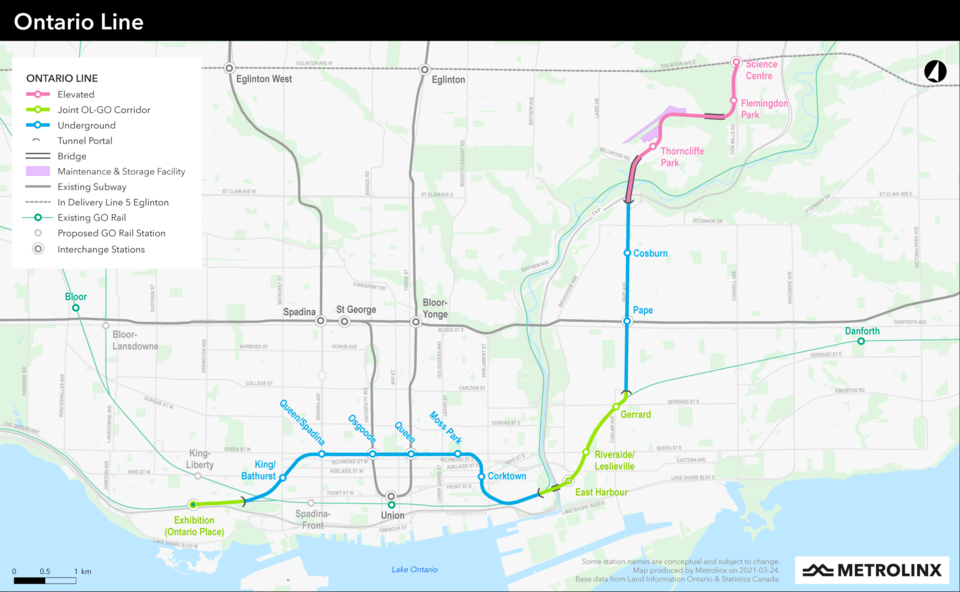
Once the Ontario Line is built, Thorncliffe Park, like many neighbourhoods along its route, will be transformed into a new transit-oriented community with tall mixed-use development at and around its new station — another signature objective of Ford’s Progressive Conservatives.
One thing making Thorncliffe Park unique is that it’ll be home to the Ontario Line’s only maintenance and storage facility (MSF). Another is the extent to which plans for the project in the area have changed.
The result, so far, is a mess.
Residents and local groups that fought for other options are unhappy. Some staple community organizations and businesses have been displaced. Overall, the project’s management has “engendered a huge distrust in government” by the community, said former premier Kathleen Wynne, who represented the riding.
A major employer in the area said he’d “much prefer” the project not be happening, even though his company will be less impacted than initially expected.
Amid the mess, some landowners may stand to profit — including a developer involved in the Greenbelt scandal, and the corporation Loblaw belongs to.
Owners of property nearby could soon find their lands’ redevelopment potential improved, according to comments from provincial and municipal officials. As a result of the massive government-led project, privately held closeby properties have likely already increased in value, a pair of planners with decades of experience told The Trillium.
One of these properties is 42 Overlea Blvd.
The Ontario Line section through Thorncliffe Park will be elevated and curve around the west side of 42 Overlea Blvd., sectioning it off from the towers to be built around the station and sparing the property from expropriation.
RCG Overlea GP Inc. and Canadian Property Holdings (Ontario) Inc. bought 42 Overlea Blvd. for $18.75 million in 2013, property records show. Wynne was premier at the time. Metrolinx and the Toronto Transit Commission (TTC) were each in early planning stages of potential projects that could someday bring a rapid transit station to Thorncliffe Park.
RCG Overlea GP Inc. is one of Michael Rice’s companies, its corporate records show. The Rice Group CEO owned land that was briefly removed from Ontario’s Greenbelt for residential construction before the Ford government’s plans collapsed in a massive scandal last year.
Canadian Property Holdings (Ontario) Inc. is part of Choice Properties, the real estate investment firm under George Weston Ltd, which also owns Loblaw.
There’s now a Costco at 42 Overlea Blvd., which its current owners built before opening in 2018. The wholesale retailer is now one of the area’s top employers.
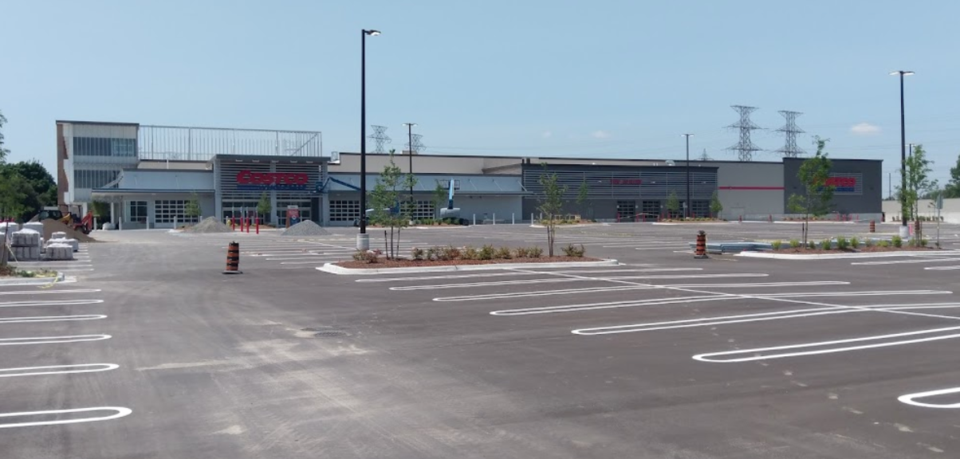
Neither owners of 42 Overlea Blvd. would say when Costco’s lease of 42 Overlea Blvd. lasts until, nor what their plans are for the property’s future.
Simone Cole, one of the directors named on Canadian Property Holdings (Ontario) Inc.’s corporate records and Choice Properties’ general counsel and secretary, told The Trillium that “Choice Properties is supportive of major infrastructure projects such as the Ontario Line. We believe that accessible public transit is great for our communities.”
“However, Choice Properties was not involved in any governmental decision-making relating to this Ontario Line and, as such, we have nothing to add to this research,” Cole added.
Before this story was published, Rice Group hadn’t responded to questions The Trillium sent it in an email.
The transit-oriented community (TOC) planned in Thorncliffe Park is set to span from 4 to 36 Overlea Blvd, the Costco’s western neighbour. Metrolinx has expropriated the properties to build the Ontario Line, its station, and the maintenance and storage facility. Infrastructure Ontario, a provincial agency that reports to the Ministry of Infrastructure, will take control of properties where the TOC will be built from Metrolinx when it comes time for the housing-focused component of the project.
At a recent virtual town hall about the Thorncliffe Park TOC, an Infrastructure Ontario adviser and a City of Toronto planner said they hadn’t talked to nearby private landowners about whether they had redevelopment plans of their own.
Nevertheless, “it’s not out of the question” that 42 Overlea Blvd. could be redeveloped, an Infrastructure Ontario adviser said in response to a question a resident of the area asked at the Feb. 29 meeting.
“(Costco) would benefit from the thousands of new customers that would be a block or two away — so I guess there is that,” the municipal planner said.
“You could also look across the street to the mall. We have over 20 malls in the city that are looking to redevelop, so that’s actually the more likely option (for redevelopment),” they added.
The East York Town Centre is the mall across the street. It’s one of several properties Morguard Corporation and its subsidiaries own in the area, along with a few high-rise apartments on Thorncliffe Park Drive — a crescent-shaped road that shapes the neighbourhood.
Morguard’s media relations team did not respond to questions The Trillium asked it in an email about what its future plans were for the properties it owns in Thorncliffe Park.
Zoning rules, other land-use designations, and — in the case of 42 Overlea Blvd. — light heritage protections could complicate future redevelopment of the Costco site and other privately owned properties in the area.
But, "those things do change over time," an Infrastructure Ontario adviser said of current land-use designations on Feb. 29.
Getting on track
The Ford government officially announced the Ontario Line as part of its first budget. Since then, plans for its route through Thorncliffe Park, the station’s location, and on what vast chunk of land the MSF will go have all changed. Metrolinx led these reconsiderations and determined the new locations, according to spokespeople from the premier’s and transportation minister’s offices.
“Neither the Minister's office nor the Minister were involved in route or location changes at any time,” said Dakota Brasier, a spokesperson for Transportation Minister Prabmeet Sarkaria, in an email. “Metrolinx proposed the initial location, route and all changes thereafter.”
Planning of an Ontario Line-esque project long predates the PCs’ election. Joint work by the municipal and provincial governments on a similar project dates back to when Ford was a councillor.
TTC-led planning involving Metrolinx ramped up while John Tory was mayor and Wynne was premier.
Days before the 2018 provincial election campaign began, Wynne announced her Liberal government signed a memorandum of understanding with the city to build a “Relief Line” subway. It was planned to be about half as long as the Ontario Line, connecting eight stops from downtown to Pape Station, a stop on Toronto’s Bloor Street subway line.
A future “Relief Line North” extension was envisioned as well, with most of the routes under consideration including a stop in Thorncliffe Park.
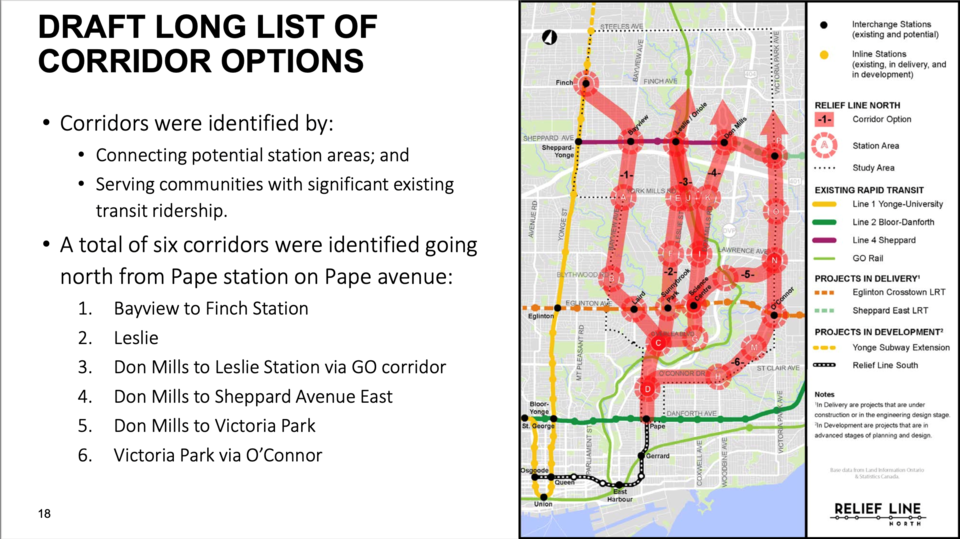
But that changed when the PCs won the June 2018 election. Ford immediately tasked key cabinet members with uploading the planning of major Toronto subway projects to the province.
The northern section of the Ford government’s version of the project, the Ontario Line, would be “largely consistent with the ‘Relief Line North’ proposal,” the PCs’ first provincial budget said.
Metrolinx’s initial business case, published about three months later in July 2019, said a station would be built “at Thorncliffe Park Drive,” with images included showing it at roughly the halfway point of the 1.8-kilometre-long Overlea Boulevard. The route of the railway itself was planned to run parallel to most of the boulevard, switching directions just west of Don Mills Road, where the Ontario Line’s two northernmost stations — Flemingdon Park and Science Centre stations — would be along.
Those plans changed a year and a half later.
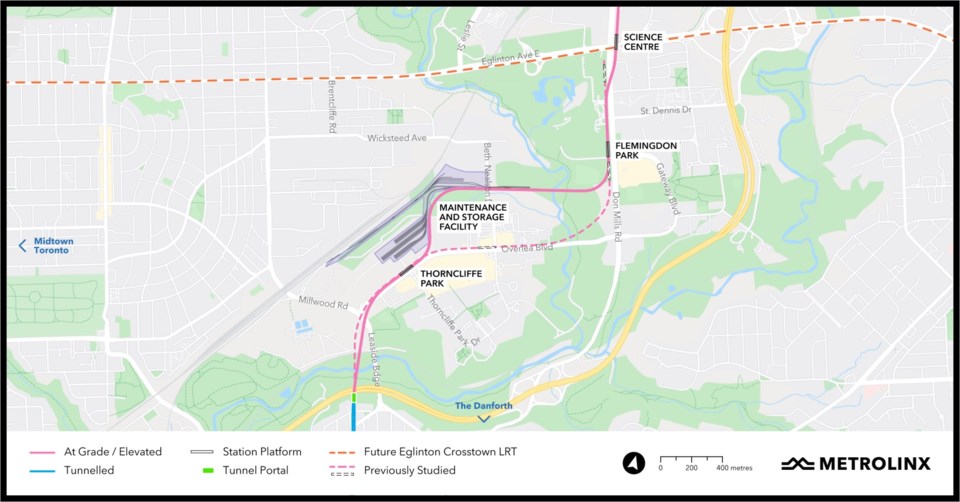
The rail route was altered to break away from Overlea Boulevard about one kilometre further to the west, aligning it with a nearby hydro corridor. Thorncliffe Park Station’s location was moved a few hundred metres west as well, nearer to the other intersection of the crescent-shaped Thorncliffe Park Drive and Overlea Boulevard.
These changes, which were finalized, were unveiled in an updated business case that Metrolinx released in December 2020.
“Metrolinx’s decision to construct the stations on the north side of Overlea Boulevard was made to minimize impacts to a number of high-density residential apartment buildings,” a spokesperson for the agency told The Trillium in an email.
Metrolinx’s December 2020 preliminary design business case relocating the railway route and station locations in Thorncliffe Park said changes would reduce costs but increase walking distances for passengers using the Ontario Line.
Like in the Relief Line North’s plans before it, the northern section of the Ontario Line was always favoured for where to locate an MSF to store dozens of trains.
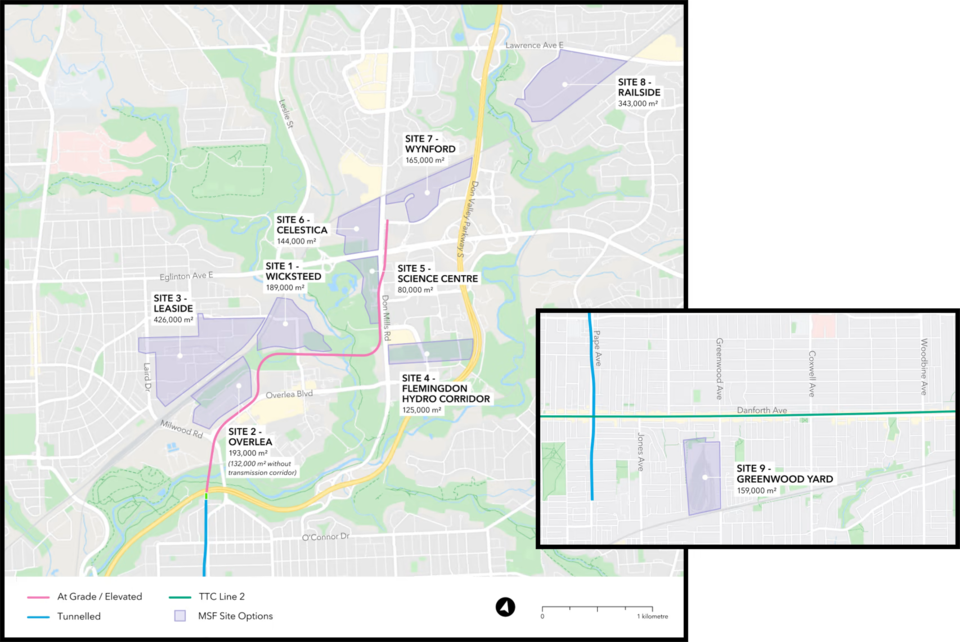
Although Metrolinx considered nine sites in total, the transit agency considered the Wicksteed area of the Leaside Business Park its “base location” from early in its planning, Metrolinx CEO Phil Verster wrote in a June 2021 letter.
Leaside includes land adjacent to Thorncliffe Park, to its north and northwest. A ravine separates the two neighbourhoods. Leaside Business Park is a historically industrial area directly north of Thorncliffe Park. Wicksteed remains a largely industrial area on the eastern side of the business park.
Metrolinx eventually narrowed its options for the MSF to the three sites closest to where the Thorncliffe Park station was planned, all within hundreds of metres of each other. They included two chunks of land in Leaside — one in Wicksteed and one to its west — and another in Thorncliffe Park, on the northern side of Overlea Boulevard.
In early April 2021, Metrolinx revealed it landed on a hybrid option combining some land in Leaside Business Park’s Wicksteed area and some in Thorncliffe Park, north of Overlea Boulevard. The choice ignited intense backlash from within the Thorncliffe Park community.
Residents and others fearing the impacts on local businesses and organizations they frequently made countless complaints. A common one, which has become synonymous with major Metrolinx projects, was that many who would be impacted felt they were left out of the decision-making process.
Multiple residents’ groups formed opposing locating the MSF in Thorncliffe Park.
Wynne was also drawn back into the mess. At the time, the former premier and transportation minister was entering what would be her last of almost 19 years as Don Valley West’s MPP. Thorncliffe Park is in the riding’s southeast corner.
In a recent interview, Wynne recalled speaking with representatives from two companies in Leaside Business Park “months” before the MSF’s placement was announced. The riding’s MPP heard “silence,” aside from what she learned from businesses.
From April to September 2021, Wynne and Rob Oliphant, a fellow Liberal and Don Valley West’s MP, organized meetings about the MSF’s placement with Thorncliffe Park residents, local groups opposing and suggesting alternatives to the plan, and Metrolinx officials.
The MSF’s placement required dozens of small businesses, including community staples like Iqbal Halal Foods, to relocate or close. There was a tense back-and-forth over the future of a mosque located on a property next door. Metrolinx eventually reached a $49.5-million deal with the Islamic Society of Toronto, including the stipulation that a new mosque and community centre “five times” as large as its prior facility would be built.
Metrolinx has stuck with the hybrid site it unveiled in early 2021, meaning community groups' efforts to advocate for a different MSF location were ultimately for naught. Wynne’s efforts to facilitate a more open and collaborative consultation about the decision were too little, too late as well.
“That was the problem, from my perspective,” Wynne said.
“I didn’t understand why we wouldn’t have gotten a heads-up from Metrolinx, or from (the transportation minister’s) office that this was happening,” Wynne added, referring to herself and Oliphant. “It didn’t make any sense to me.”
Wynne said she and Oliphant were “put in the position of trying to translate what was happening with one group” being impacted to other groups involved.
“I think it came out of a fear that if everybody was at the table together, it would devolve into conflict, but it devolved into conflict anyway, because everybody felt that there was secrecy and they weren't being given the whole story,” Wynne said.
“In retrospect… the problem was Metrolinx did not look at the whole community — the (Leaside) Business Park, the small businesses in Thorncliffe, and the residential community (altogether),” Wynne said. “It was like they were trying to pick off and divide and conquer.”
Bittersweet for the business park
Metrolinx first favoured the Wicksteed area of the Leaside Business Park for where to put the MSF because it seemed to check many of the agency’s boxes. It had enough space, fulfilled technical requirements, and presented the cheapest possibility, according to Metrolinx records.
While jobs would be lost by companies having to vacate Wicksteed, that would be the case anywhere.
As Metrolinx more closely examined the potential impacts on each of the areas it was considering, it concluded that displacing businesses in Wicksteed would risk further-reaching implications, agency records show.
Leaside Business Park is one of the increasingly rare industrial areas south of Toronto’s Eglinton Avenue. The area’s heyday as a hub for manufacturing jobs was decades ago. It remains home to some long-operating plants that collectively employ thousands. Its future has been an oft-revisited topic by Toronto’s city council over the last couple of decades.
The provincial transit agency started discussions with two manufacturers with long operating histories in Wicksteed in the fall of 2020, Verster, Metrolinx’s CEO, wrote in a June 2021 letter. The companies, Siltech and Tremco, were the same businesses Wynne began hearing from about the MSF around that time.
Dag Enhorning, Siltech’s president, told The Trillium the silicone-based chemical manufacturer learned Metrolinx was considering locating the MSF at its property when the agency called the company asking permission to conduct soil sampling.
About 100 employees work at Siltech’s site in Leaside, which doubles as the company’s headquarters and one of its two manufacturing plants. Enhorning said in an interview that many of its Leaside plant employees make over $100,000 a year; “They’re not low-paid jobs,” he said.
Siltech was adamantly against relocating.
“Moving a plant like this is not an easy undertaking,” Enhorning said. “So we’d have to be fully operational at a different space before we start disassembling this one, because otherwise we’d lose all that business. It’s not like a retail site where you just pop it open and move all your goods to a different location. It would have taken well over a year.”
Siltech’s president said the company and Metrolinx had “a couple of meetings over a few months” while the agency was figuring out where to place the MSF.
Verster wrote in June 2021 that Metrolinx determined through discussions with Siltech and Tremco “that a relocation was not feasible for either company and that expropriating the land could lead to the businesses leaving not only the city, but possibly the region or the country entirely.”
Following discussions with businesses in Wicksteed, Metrolinx estimated that using the originally favoured site as its MSF would force 800 to 1,050 people to lose jobs. These would largely be specialized manufacturing jobs that Metrolinx believed wouldn’t likely pop up elsewhere in Toronto.
Although Metrolinx suggested different estimates at different times about the domino effect that forcing Wicksteed businesses to close would have, agency records make clear that it feared the possibility.
“The supply chain and indirect job impact of this would be at least 4-5 times the impact of the direct jobs,” Verster wrote in June 2021.
“The supply chain for the associated businesses at Wicksteed could have as much as an 8x multiplier on indirect jobs,” Metrolinx wrote in response to questions from a group opposing the MSF’s placement.
The agency’s fear of potentially causing thousands of job losses led it to examine the Overlea site more carefully, according to Verster. Metrolinx also believed the nearby site in Thorncliffe Park posed the next-lowest cost option.
Eventually, the agency landed on the hybrid option: it would build operational, maintenance and storage facilities on the north side of the ravine, and it would locate land south of the ravine as a trainyard.
Metrolinx estimated that 400 to 700 people would lose their jobs at businesses it would take over land from. But many of these could be “retained and locally relocated,” as was the case for the businesses, according to Verster.
Properties Metrolinx ended up expropriating north of the ravine included one property apiece owned by Tremco and Lincoln Electric Co., manufacturers that have each operated in the area for 90 years or longer.
Tremco makes roofing, sealants, caulking, and waterproofing products.
Lincoln Electric Co. specializes in manufacturing products used in welding.
Each business is one of the area’s top employers with upwards of around 200 employees each in Leaside.
In September 2021, months after Metrolinx revealed where it planned to locate the Ontario Line’s MSF, Tremco’s parent company sold the other two properties it owned in Leaside to a real estate investment company for almost $50 million. In conjunction with the sale, Tremco’s U.S.-based parent company RPM International Inc. also reached a leaseback agreement on the properties that lasts until September 2024.
“The purpose of the transaction was to generate cash by monetizing a real estate market opportunity,” RPM International Inc.’s 2023 annual report says.
Lincoln Electric Co. still owns one other property in Leaside. Metrolinx took over the property where its distribution centre was based.
The Trillium emailed both Lincoln Electric Co. and Tremco asking them about their future plans in the Leaside Business Park, but hadn’t heard back from either company before this story’s publication.
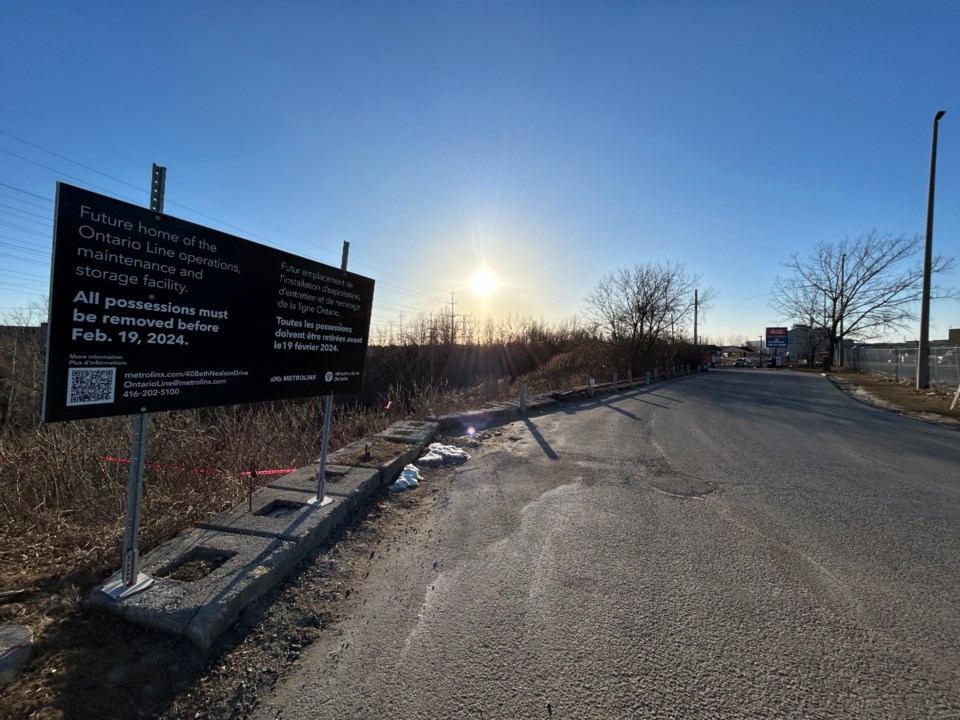
Siltech, meanwhile, has “no desire to leave” the area it has operated in since 1997, its president said.
Siltech’s other plant is in Mississauga. It’s building a third plant in Fort Erie, which the provincial government granted the company $5 million for. Siltech’s new $100-million facility will allow it to “double” the output of its Leaside and Mississauga plants, and introduce new product lines, according to the company’s website. It hopes to open its Fort Erie plant in about a year, according to Enhorning.
And while Siltech’s president said he recognizes the MSF and the projects it's connected to are required given Toronto’s continued growth, he’d “much prefer” they weren’t happening so close to Siltech.
“It affects us in a big way and it reduces the industrial footprint within the (business) park… It’s going to have a significant impact on traffic as people are making their way to this station,” Enhorning said. “We handle a lot of trucks in the (business) park and there’s going to be a big impact from all the additional traffic.”
The Thorncliffe Park of the future
Once work is finished in Thorncliffe Park on the Ontario Line, its station and the MSF, construction can then begin on the TOC.
TOCs are major housing-focused projects that will also include other mixed-use spaces, like retail stores, to make areas around key transit stops desirable places to live.
The Ford government signalled in its 2019 budget that it would work toward densifying major transit areas through TOC projects. It added a Thorncliffe Park TOC to its list last October. There are 14 in total that are currently planned, most of which are at Ontario Line stations.
Ford’s office has closely monitored the government’s TOCs’ plan. Calendars obtained using freedom-of-information requests show that over a few months in early 2023, multiple senior staff in the premier’s office had biweekly TOCs’ meetings with officials from the ministries of municipal affairs and housing and infrastructure, along with officials from Infrastructure Ontario and the Cabinet Office.
“As is the case with any major government policy, the premier’s office is involved with overall policy direction based on advice from non-partisan officials with transit planning and development expertise,” a spokesperson for Ford told The Trillium in an email.
Agencies like Infrastructure Ontario and Metrolinx are responsible for managing “land acquisition and assembly” of TOC projects, Ford’s spokesperson added.
As the Thorncliffe Park TOC has been planned so far, it’s set to include five main buildings on about 6.5 acres of land on the north side of Overlea Boulevard and the Ontario Line track.
Redevelopment of the 20 Overlea Blvd. property — which the Islamic Society of Toronto will retain control of — is happening separately from the TOC project. Its “expansion and renovation… will act as a community anchor and destination,” a plan published by Infrastructure Ontario says.
The provincial infrastructure agency’s preliminary planning documents for the Thorncliffe Park TOC show four main buildings reaching 46 and 56 stories high. The fifth, at 36 Overlea Blvd., which the Ontario Line will curve around, is planned to be 13 stories high. Altogether, they’re supposed to include up to 2,660 new residential units, including some affordable units, 16,000 square metres of office space, and 6,700 square metres of retail space.
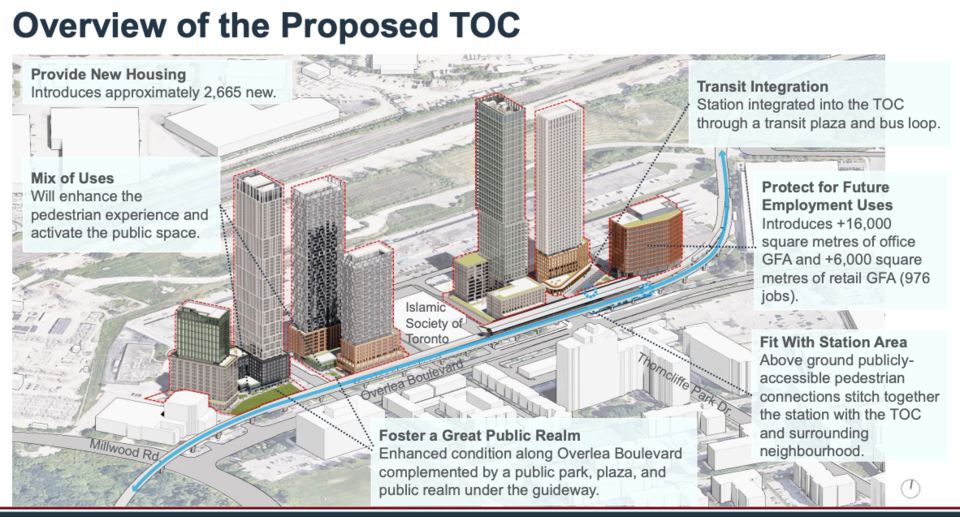
The Ontario Line is projected to be completed by 2031, according to the government’s latest estimate. The elevated section that’ll go through Thorncliffe Park is supposed to be easier, and take less time, to build. Construction that began earlier this year aims to allow elevated guideways and the Thorncliffe Park station to start being built by late 2025. But, as Torontonians know all too well, transit projects’ timelines can be hard to predict.
Last year marked the first time the Ford government set aside significant funding for any of its TOCs. It planned to spend more than $330 million on its TOC project in East Harbour, another stop along the Ontario Line. Much, if not all, of this amount ended up unspent in 2023-24 because of delays.
As part of Ford’s and Toronto Mayor Olivia Chow’s “new deal” for the city, the mayor agreed on “advancing transit-oriented communities by prioritizing approvals and finalization of agreements for the development of East Harbour” and others.
In any event, the “vibrant mixed-use community” that the provincial government has promised to turn Thorncliffe Park into is a dream of a decade or more away.
Whether that’s enough time to win back the community’s trust remains to be seen.

